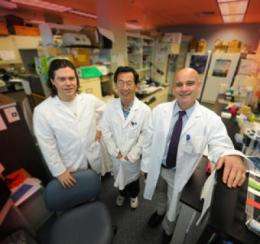Neuron-nourishing cells appear to retaliate in Alzheimer’s Credit: Phil Jones, Georgia Health Sciences University photographer
When brain cells start oozing too much of the amyloid protein that is the hallmark of Alzheimer's disease, the astrocytes that normally nourish and protect them deliver a suicide package instead, researchers report.
Amyloid is excreted by all neurons, but rates increase with aging and dramatically accelerate in Alzheimer's. Astrocytes, which deliver blood, oxygen and nutrients to neurons in addition to hauling off some of their garbage, get activated and inflamed by excessive amyloid.
Now researchers have shown another way astrocytes respond is by packaging the lipid ceramide with the protein PAR-4, which independently can do damage but together are a more "deadly duo," said Dr. Erhard Bieberich, biochemist at the Medical College of Georgia at Georgia Health Sciences University.
"If the neuron makes something toxic and dumps it at your door, what would you do?" said Bieberich, corresponding author of the study published in the Journal of Biological Chemistry. "You would probably do something to defend yourself."
The researchers hypothesize that this lipid-coated package ultimately kills them both, which could help explain the brain-cell death and shrinkage that occurs in Alzheimer's. "If the astrocytes die, the neurons die," Bieberich said, noting studies suggest that excess amyloid alone does not kill brain cells. "There must be a secondary process toxifying the amyloid; otherwise the neuron would self-intoxicate before it made a big plaque," he said. "The neuron would die first."
One of many avenues for future pursuit include whether a ceramide antibody could be a viable Alzheimer's treatment. In the researchers' studies of brain cells of humans with Alzheimer's as well as an animal model of the disease, antibodies to ceramide and Par-4 prevented astrocytes' amyloid-induced death.
Ceramide and Par-4 get packaged in lipid-coated vesicles called exosomes; all cells secrete thousands of these vesicles but scientists are only beginning to understand their normal function. When exosomes become deadly, they are called apoxosomes.
Ceramide and Par-4 are typically not in a vesicle, rather in two distinct parts of a cell. Ceramide appears to take the lead in bringing the two together when confronted with amyloid. Bieberich and colleagues at the University of Georgia reported in 2003 that the deadly duo helps eliminate duplicate brain cells that occur early in brain development when their survival could result in a malformed brain. They suspected then that the duo might also have a role in Alzheimer's.
Risk factors for Alzheimer's include aging, family history and genetics, according to the Alzheimer's Association. Increasing evidence suggests that Alzheimer's also shares many of the same risk factors for cardiovascular disease, such as high cholesterol, high blood pressure and inactivity.
Journal information: Journal of Biological Chemistry
Provided by Georgia Health Sciences University





















